The ongoing expansion of the Texas A&M AgriLife Bill Sims Wool and Mohair Research Laboratory is an exciting new chapter in a story of service by Texas A&M University to the animal fiber industry that goes back over 100 years.
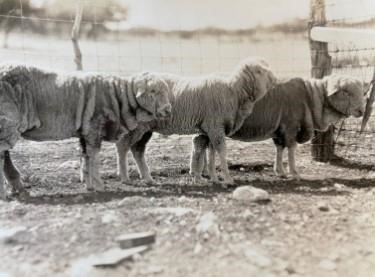
Rambouillet ewes at a Texas A&M research station in 1933. (Texas A&M AgriLife photo)
The Bill Sims Wool and Mohair Research Laboratory was established in 1985 to address the needs of national wool and mohair research programs. The wool lab, originally on the Texas A&M campus, is now in a region of Texas that supports approximately 20% of the U.S. sheep population and 90% of the Angora goats in the nation.
Scientists at the wool lab conduct key high-priority research projects for sheep and goat raisers throughout the country.
The research done on objective measurement of fiber has been critical in developing improved flocks of fine-wool producing sheep, as well as ensuring domestic wool meets the required international testing specifications for commercial trade.
Lab analysis and testing
As the lab’s name implies, improvements in Angora goats and mohair have also long been a focus. As a result, Texas remains not only the largest wool producer in the U.S. but also the largest mohair producer, showcasing some of the best Angora goat genetics in the world.
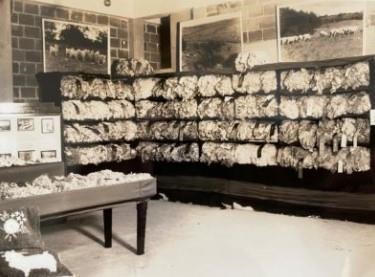
The Wool and Mohair Exhibit at the Texas Centennial Expo in Dallas in 1936. (Texas A&M AgriLife photo)
Housed at the Texas A&M AgriLife Research and Extension Center in San Angelo, the lab offers a nationwide service analyzing fiber samples for quality and yield. San Angelo is one of only two research laboratories that provide those services in the U.S. and the only one to offer– as a result of its current expansion — large-scale commercial testing required for the global trade of wool.
Although the lab is in full swing with renovations as new high-capacity commercial testing equipment arrives, individual fleece-testing services continue to be offered to growers.
“We provide timely and meaningful information to producers about their animal’s fiber, based on their samples we analyze,” said Ronald Pope, Ph.D., Texas A&M AgriLife Research animal fiber scientist, San Angelo.
Pope explained knowing which animals produce the best fiber is crucial in improving breeding programs and producers’ bottom lines. The lab can analyze fiber diameter, length and yield.
Longtime wool leaders
Before the Bill Sims Wool Lab was established in 1985, there was a research lab and a wool-processing plant at Texas A&M University in College Station that originated between 1919-1921, said Dawn Brown, Bill Sims Wool Lab manager, San Angelo. Much of the early work done there helped to shape the genetic selection of the modern-day Rambouillet sheep.
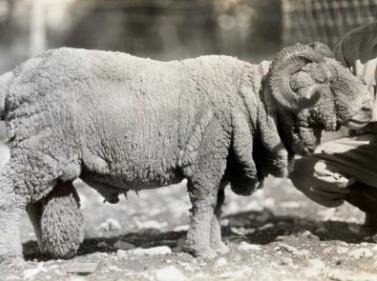
A Rambouillet ram from the 1930s, an example of the breed standard for that time. (Texas A&M photo)
The Rambouillet is the predominant fine-wool sheep breed found in Texas. Its range-hardy nature has also led it to be found in great numbers across many large western wool-producing states. It is also sometimes referred to as the French cousin of the well-known Spanish Merino sheep breed.
“If you look at old pictures of Rambouillet, how they look now is worlds apart from how the breed looked back then,” said Brown. “Texas A&M AgriLife has been instrumental in influencing the genetic and progeny selection that produce the profitable characteristics we see today in Rambouillet flocks across the U.S.”
Over the last 105 years, Texas A&M AgriLife scientists have produced volumes of research reports and findings that had far-reaching effects throughout the fiber industry.
A 1957 paper, “The Feasibility of Processing Wool and Mohair in Texas,” addressed processing challenges and issues. A 1961 report entitled “Wool Marketing Problems in Texas” discussed the problems with selling wool based on physical inspection alone. Carelessness in shearing and poor handling methods were also discussed as impairing not only the quality but the price producers could receive from their fleeces.
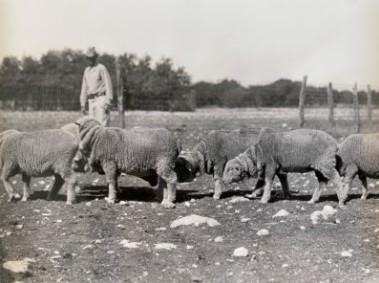
Sheep in 1933 at the Texas State Station, now known as the Texas A&M AgriLife Research and Extension Center – San Angelo’s Sonora Station. (Texas A&M AgriLife photo)
From resistance-to-compression studies that showed American wool was suitable to produce the finest fabrics to address market concerns, the research done through Texas A&M has helped shape the U.S. wool industry for well over 100 years as well as influence global markets.
Texas A&M AgriLife researchers published “Improvement of Sheep Through the Selection of Performance-Tested and Progeny-Tested Breeding Animals” based on its 1950-51 study. Today, advances in genetics and research make it easier than ever for producers to know and select their best animals to breed. The continued success over the years of AgriLife Research’s performance tests, which assist breeders in identifying their superior animals, is a testament to the importance of the work scientists and researchers continue to do.
Recent wool lab innovations
The contributions the Bill Sims Wool Lab and its precursors have made to the industry even just over the last 50 years have been remarkable, Brown said. Utilizing the latest technology and equipment, the wool lab helps lead advancements in academic and scientific sheep-related studies and puts those innovations into use to serve the commercial industry.
The research conducted at the wool lab has increased the use of pre-sale objective measurements for raw wool and mohair transactions, resulting in value-based marketing systems and more equitable prices for producers. The wool lab has also been key in the widespread use by American wool producers of skirting and classing as value-adding practices prior to the sale of raw material.
The wool lab, Texas A&M AgriLife Extension Service specialists and AgriLife Research scientists have also been involved in collaborative studies of several new breeds and crossbreeds of sheep conducted in western Texas and nationally. They are also responsible for shaping much of our current knowledge on the effects of North American environments on fiber production by sheep.
Upcoming field day, wool lab panel Aug. 20
Brown and Pope will speak on the history and future of the wool lab on Aug. 20 as part of the 48th Annual Sheep and Goat Field Day. They will also moderate a discussion from producers and individuals involved with the wool lab and industry over its history.
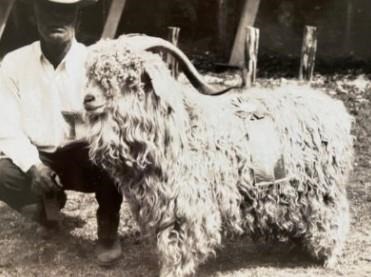
The grand champion Angora goat at the 1930 Texas Angora Goat Breeders Association Show. (Texas A&M AgriLife photo)
“The field day provides an opportunity for producers and the public to come to the San Angelo center and get to see the wool lab facility firsthand and gain a better understanding of what we do and how we do it,” said Brown. “Not only will we be discussing the rich history of the wool lab, but our ongoing projects and the exciting future we envision.”
The newly expanded laboratory will utilize state-of-the-art machinery and technology in its service to American wool and mohair producers. It will also continue to provide innovative research and testing services for cashmere and alpaca fibers.
“Natural fibers from sheep and goats are at the forefront of the sustainable textile industry,” Pope said. “Combine that with the numerous benefits they bring to the land upon which they roam, and well, no other fiber can compete. It’s a great time to celebrate an industry that has strived over a century to develop improvements that ensure a productive and environmentally sound future.”
Source : tamu.edu